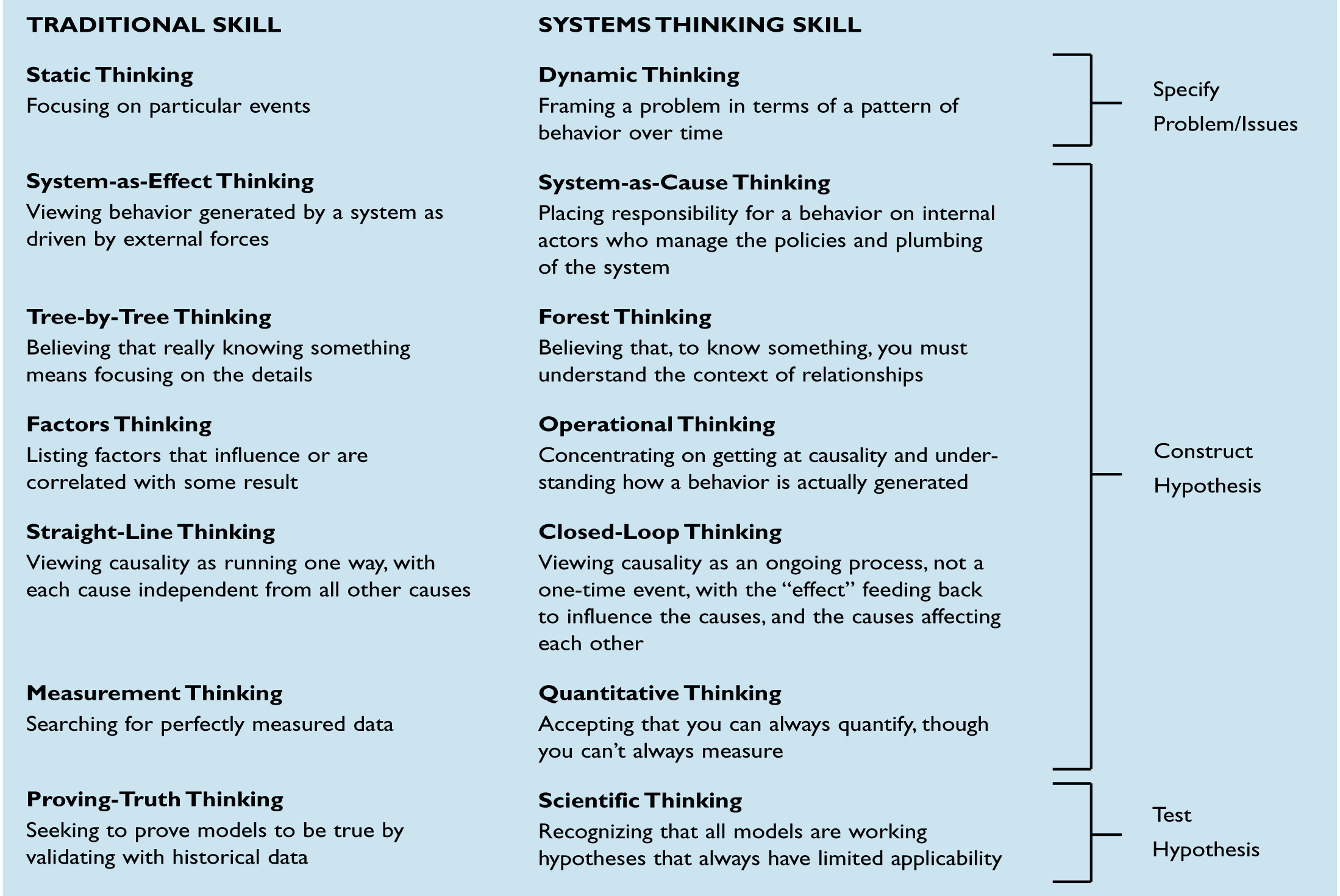Despite significant advances in personal computers and systems thinking software over the last decade, learning to apply systems thinking effectively remains a tough nut to crack. Many intelligent people continue to struggle far too long with the systems thinking paradigm, thinking process, and methodology.
From my work with both business and education professionals over the last 15 years, I have come to believe that systems thinking’s steep learning curve is related to the fact that the discipline requires mastering a whole package of thinking skills.
STEPS IN THE SYSTEMS THINKING METHOD
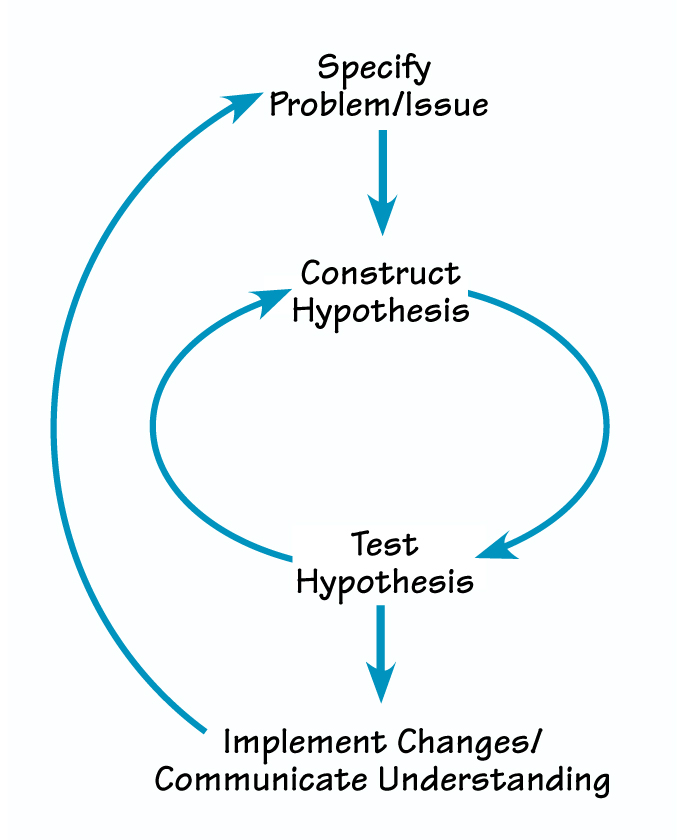
Begin by specifying the problem you want to address. Then construct hypotheses to explain the problem and test them using models. Only when you have a sufficient understanding of the situation should you begin to implement change.
Much like the accomplished basketball player who is unaware of the many separate skills needed to execute a lay-up under game conditions – such as dribbling while running and without looking at the ball, timing and positioning the take-off, extending the ball toward the rim with one hand while avoiding the blocking efforts of defenders – veteran systems thinkers are unaware of the full set of thinking skills that they deploy while executing their craft. By identifying these separate competencies, both new hoop legends and systems thinking wannabes can practice each skill in isolation. This approach can help you master each of the skills before you try to put them all together in an actual game situation.
The Systems Thinking Method
Before exploring these critical thinking skills, it’s important to have a clear picture of the iterative, four-step process used in applying systems thinking (see “Steps in the Systems Thinking Method”). In using this approach, you first specify the problem or issue you wish to explore or resolve. You then begin to construct hypotheses to explain the problem and test them using models whether mental models, pencil and paper models, or computer simulation models. When you are content that you have developed a workable hypothesis, you can then communicate your new found clarity to others and begin to implement change.
When we use the term “models” in this article, we are referring to something that represents a specifically defined set of assumptions about how the world works. We start from a premise that all models are wrong because they are incomplete representations of reality, but that some models are more useful than others (they help us understand reality better than others). There is a tendency in the business world, however, to view models (especially computer-based models) as “answer generators;” we plug in a bunch of numbers and get out a set of answers. From a systems thinking perspective, however, we view models more as “assumptions and theory testers” we formulate our understanding and then rigorously test it. The bottom line is that all models are only as good as the quality of the thinking that went into creating them. Systems thinking, and its ensemble of seven critical thinking skills, plays an important role in improving the quality of our thinking.
The Seven Critical Thinking Skills
As you undertake a systems thinking process, you will find that the use of certain skills predominates in each step. I believe there are at least seven separate but interdependent thinking skills that seasoned systems thinkers master. The seven unfold in the following sequence when you apply a systems thinking approach: Dynamic Thinking, System-as-Cause Thinking, Forest Thinking, Operational Thinking, Closed-Loop Thinking, Quantitative Thinking, and Scientific Thinking.
The first of these skills, Dynamic Thinking, helps you define the problem you want to tackle. The next two, System-as-Cause Thinking and Forest Thinking, are invaluable in helping you to determine what aspects of the problem to include, and how detailed to be in representing each. The fourth through sixth skills, Operational Thinking, Closed-Loop Thinking, and Quantitative Thinking, are vital for representing the hypotheses (or mental models) that you are going to test. The final skill, Scientific Thinking, is useful in testing your models.
Each of these critical thinking skills serves a different purpose and brings something unique to a systems thinking analysis. Let’s explore these skills, identify how you can develop them, and determine what their “non-systems thinking” counterparts (which dominate in traditional thinking) look like.
Dynamic Thinking: Dynamic Thinking is essential for framing a problem or issue in terms of a pattern of behavior over time. Dynamic Thinking contrasts with Static Thinking, which leads people to focus on particular events. Problems or issues that unfold over time as opposed to one-time occurrences are most suitable for a systems thinking approach.
You can strengthen your Dynamic Thinking skills by practicing constructing graphs of behavior overtime. For example, take the columns of data in your company’s annual report and graph a few of the key variables over time. Divide one key variable by another (such as revenue or profit by number of employees), and then graph the results. Or pick up today’s news-paper and scan the head-lines for any attention-grabbing events. Then think about how you might see those events as merely one interesting point in a variable’s overall trajectory over time. The next time someone suggests that doing this-and-that will fix such-and-such, ask, “Over what time frame? How long will it take? What will happen to key variables over time?”
System-as-Cause Thinking: Dynamic Thinking positions your issue as a pattern of behavior over time. The next step is to construct a model to explain how the behavior arises, and then suggest ways to improve that behavior. System-as-Cause Thinking can help you determine the extensive boundary of your model, that is, what to include in your model and what to leave out (see “Extensive and Intensive Model Boundaries”). From a System-as-Cause Thinking approach, you should include only the elements and inter-relationships that are within the control of managers in the system and are capable of generating the behavior you seek to explain.
By contrast, the more common System-as-Effect Thinking views behavior generated by a system as “driven” by external forces. This perspective can lead you to include more variables in your model than are really necessary. System-as-Cause Thinking thus focuses your model more sharply, because it places the responsibility for the behavior on those who manage the policies and plumbing of the system itself.
To develop System-as-Cause Thinking, try turning each “They did it” or “It’s their fault” you encounter into a “How could we have been responsible?” It is always possible to see a situation as caused by “outside forces.” But it is also always possible to ask, “What did we do to make ourselves vulnerable to those forces that we could not control?”
EXTENSIVE AND INTENSIVE MODEL BOUNDARIES
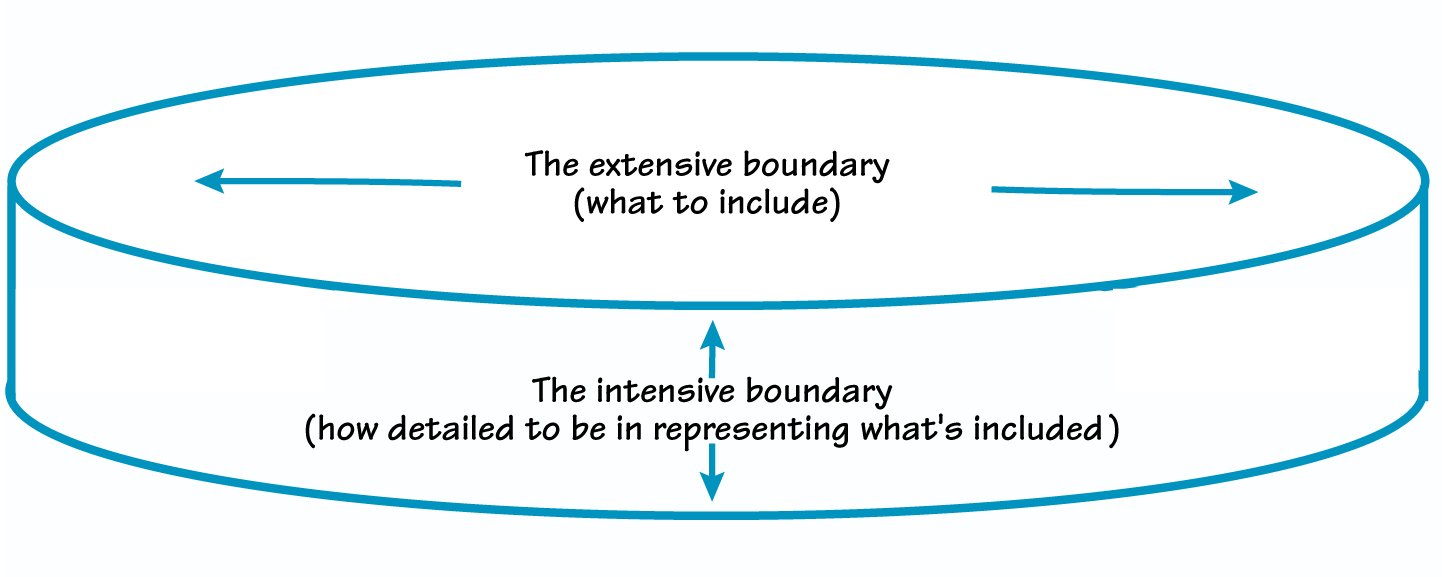
The extensive boundary is the breadth or scope of what’s included in the model. The intensive boundary is the depth or level of detail at which the items included in the model are represented.
Forest Thinking: In many organizations, people assume that to really know something, they must focus on the details. This assumption is reinforced by day-to-day existence—we experience life as a sequence of detailed events. We can also think of this as Tree-by-Tree Thinking. Models that we create by applying Tree-by-Tree Thinking tend to be large and overly detailed; their intensive boundaries run deep. In using such models, we would want to know whether that particular red truck broke down on Tuesday before noon, as opposed to being interested in how frequently, on average, trucks break down. Forest Thinking–inspired models, by contrast, group the details to give us an “on average” picture of the system. To hone your Forest Thinking skills, practice focusing on similarities rather than differences. For example, although everyone in your organization is unique, each also shares some characteristics with others. While some are highly motivated to perform and others are not, all have the potential to make a contribution. Regardless of the individual, realizing potential within an organization comes from the same generic structure. For example, what is the relationship among factors that tends to govern an individual’s motivation?
Operational Thinking :Operational Thinking tries to get at causality—how is behavior actually generated? This thinking skill contrasts with Correlational or Factors Thinking. Steven Covey’s The Seven Habits of Highly Effective People, one of the most popular nonfiction books of all time, is a product of Factors Thinking. So are the multitude of lists of “Critical Success Factors” or “Key Drivers of the Business” that decorate the office walls (and mental models) of so many senior executives. We like to think in terms of lists of factors that influence or drive some result.
There are several problems with mental models bearing such list structures, however. For one thing, lists do not explain how each causal factor actually works its magic. They merely imply that each factor “influences,” or is “correlated with,” the corresponding result. But influence or correlation is not the same as causality.
For example, if you use Factors Thinking to analyze what influences learning, you can easily come up with a whole “laundry list” of factors (see “Two Representations of the Learning Process”). But if you use Operational Thinking, you might depict learning as a process that coincides with the building of experience. Operational Thinking captures the nature of the learning process by describing its structure, while Factors Thinking merely enumerates a set of factors that in some way “influence” the process.
To develop your Operational Thinking skills, you need to work your way through various activities that define how a business works examine phenomena such as hiring, producing, learning, motivating, quitting, and setting price. In each case, ask, “What is the nature of the process at work?” as opposed to “What are all of the factors that influence the process?”
Closed-Loop Thinking :Imagine discussing your company’s profitability situation with some of your coworkers. In most companies, the group would likely list things such as product quality, leadership, or competition as influences on profitability (see “A Straight-Line vs. a Closed-Loop View of Causality”). This tendency to list factors stems from Straight-Line Thinking. The assumptions behind this way of thinking are 1) that causality runs only one way—from “this set of causes” to “that effect,” and 2) that each cause is independent of all other causes. In reality, however, as the closed-loop part of the illustration shows, the “effect” usually feeds back to influence one or more of the “causes,” and the causes themselves affect each other. Closed-Loop Thinking skills therefore lead you to see causality as an ongoing process, rather than a one-time event.
To sharpen your Closed-Loop Thinking skills, take any laundry list that you encounter and think through the ways in which the driven drives and in which the drivers drive each other. Instead of viewing one variable as the most important driver and another one as the second most important, seek to understand how the dominance among the variables might shift over time.
TWO REPRESENTATIONS OF THE LEARNING PROCESS
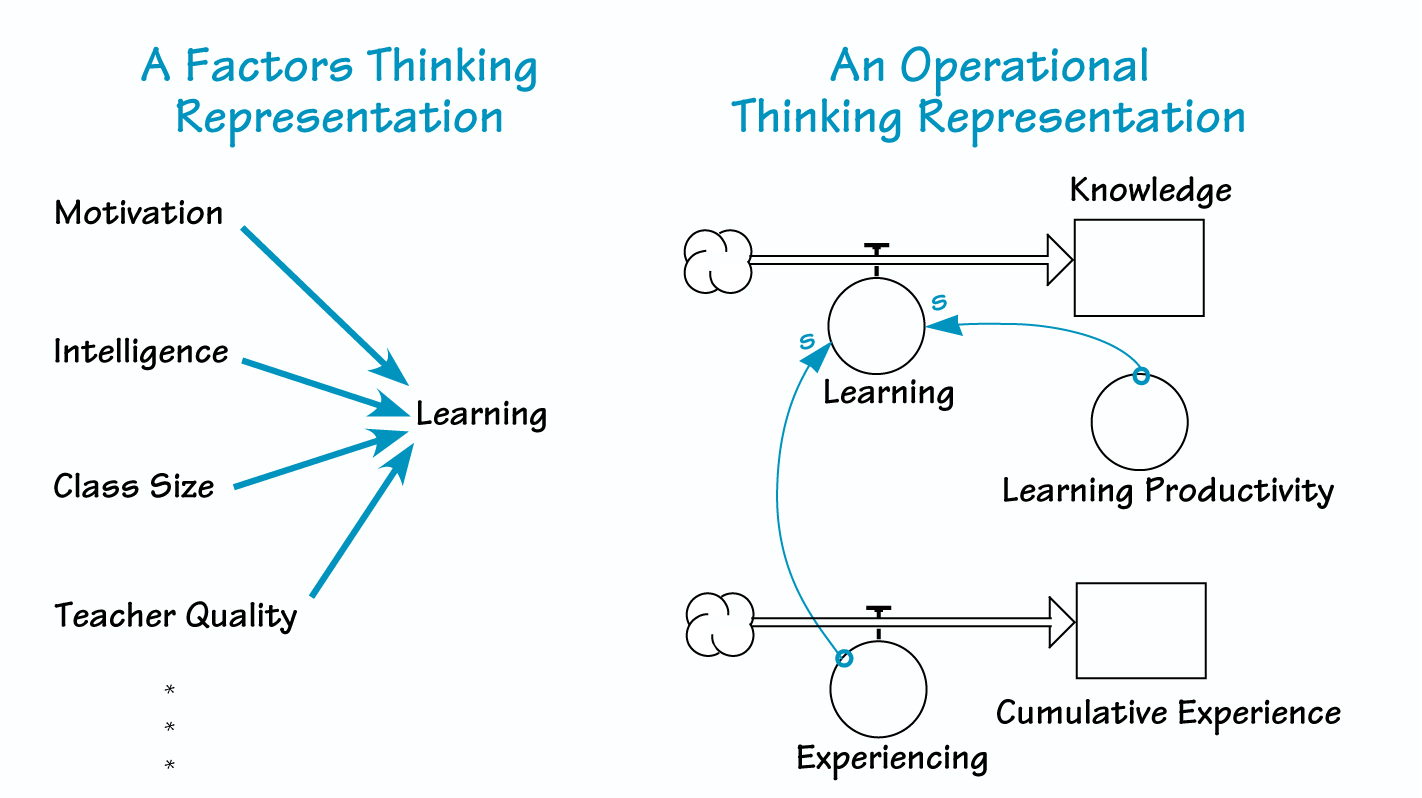
Factors Thinking merely enumerates a set of factors that in some way “influence” the learning process. Operational Thinking captures the nature of the learning process by describing its structure.
Quantitative Thinking: In this phrase, “quantitative” is not synonymous with “measurable.” The two terms are often confused in practice, perhaps because of the presumption in the Western scientific world that “to know, one must measure precisely.” Although Heisenberg’s Uncertainty Principle caused physicists to back off a bit in their quest for numerical exactitude, business folk continue unabated in their search for perfectly measured data. There are many instances of analysis getting bogged down because of an obsession with “getting the numbers right.” Measurement Thinking continues to dominate!
There are a whole lot of things, however, that we will never be able to measure very precisely. These include “squishy,” or “soft,” variables, such as motivation, self-esteem, commitment, and resistance to change. Many so-called “hard” variables are also difficult to measure accurately, given the speed of change and the delays and imperfections in information systems.
A STRAIGHT-LINE VS.A CLOSED-LOOP VIEW OF CAUSALITY
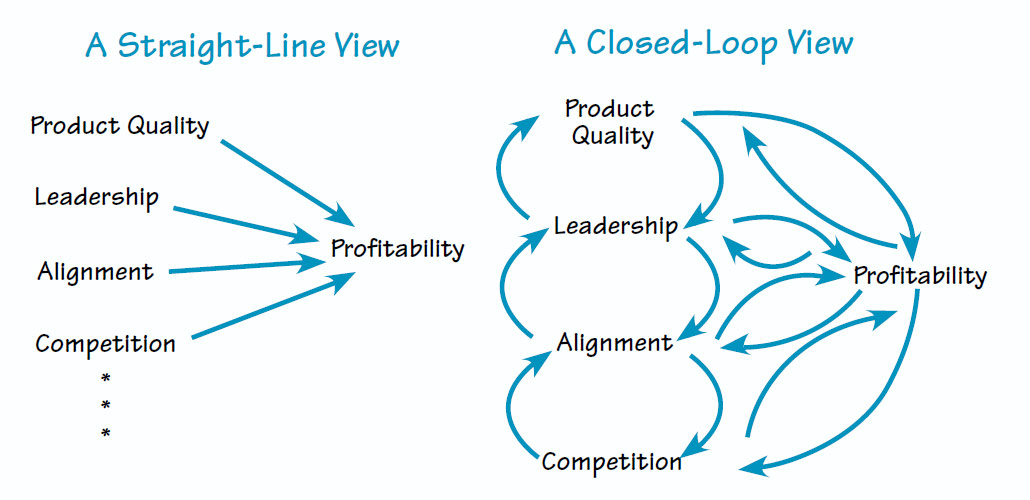
The assumptions behind Straight-Line Thinking are that causality runs only one way and that each cause is independent of all other causes. Closed-Loop Thinking shows that the “effect” usually feeds back to influence one or more of the “causes,” and the causes themselves affect each other.
But let’s return to our “squishy” variables. Would anyone want to argue that an employee’s self-esteem is irrelevant to her performance? Who would propose that commitment is unimportant to a company’s success? Although few of us would subscribe to either argument, things like self-esteem and commitment rarely make it into the spreadsheets and other analytical tools that we use to drive analysis. Why? Because such variables can’t be measured. However, they can be quantified. If zero means a total absence of commitment, 100 means being as committed as possible. Are these numbers arbitrary? Yes. But are they ambiguous? Absolutely not! If you want your model to shed light on how to increase strength of commitment as opposed to predicting what value commitment will take on in the third-quarter of 1997—you can include strength of commitment as a variable with no apologies. You can always quantify, though you can’t always measure.
To improve your Quantitative Thinking skills, take any analysis that your company has crunched through over the last year and ask what key “soft” variables were omitted, such as employee motivation. Then, ruminate about the possible implications of including them systems thinking gives you the power to ascribe full-citizen status to such variables. You’ll give up the ability to achieve perfect measurement. But if you’re honest, you’ll see that you never really had that anyway.
Scientific Thinking: The final systems thinking skill is Scientific Thinking. I call its opposite Proving Truth Thinking. To understand Scientific Thinking, it is important to acknowledge that progress in science is measured by the discarding of falsehoods. The current prevailing wisdom is always regarded as merely an “entertainable hypothesis,” just waiting to be thrown out the window. On the other hand, too many business models are unscientific; yet business leaders revere them as truth and defend them to the death. Analysts make unrelenting efforts to show that their models track history and therefore must be “true.”
Seasoned systems thinkers continually resist the pressure to “validate” their models (that is, prove truth) by tracking history. Instead, they work hard to become aware of the falsehoods in their models and to communicate these to their team or clients. “All models are wrong,”” said W. Edwards Deming. “Some models are useful.” Deming was a smart guy, and clearly a systems thinker.
In using Scientific Thinking, systems thinkers worry less about outfitting their models with exact numbers and instead focus on choosing numbers that are simple, easy to understand, and make sense relative to one another. Systems thinkers also pay lots of attention to robustness they torture-test their models to death! They want to know under what circumstances their model “breaks down.” They also want to know, does it break down in a realistic fashion? What are the limits to my confidence that this model will be useful?
The easiest way to sharpen your Scientific Thinking skills is to start with a computer model that is “in balance” and then shock it. For example, transfer 90% of the sales force into manufacturing. Set price at 10 times competitor price. Triple the customer base in an instant. Then see how the model performs. Not only will you learn a lot about the range of utility of the model, but you also will likely gain insight into the location of that most holy of grails: high-leverage intervention points.
A Divide and Conquer Strategy
As the success of Peter Senge’s The Fifth Discipline: The Art & Practice of the Learning Organization has shown, systems thinking is both sexy and seductive. But applying it effectively is not so easy. One reason for this difficulty is that the thinking skills needed to do so are many in number and stand in stark contrast to the skill set that most of us currently use when we grapple with business issues (see “Traditional Business Thinking vs. Systems Thinking Skills”).
By separating and examining the seven skills required to apply systems thinking effectively, you can practice them one at a time. If you master the individual skills first, you stand a much better chance of being able to put them together in a game situation. So, practice . . . then take it to the hoop!
“Barry Richmond is the managing director and founder of High Performance Systems, Inc. He has a PhD in system dynamics from the MIT Sloan School of Management, an MS from Case Western Reserve, and an MBA from Columbia University”
TRADITIONAL BUSINESS THINKING VS. SYSTEMS THINKING SKILLS
